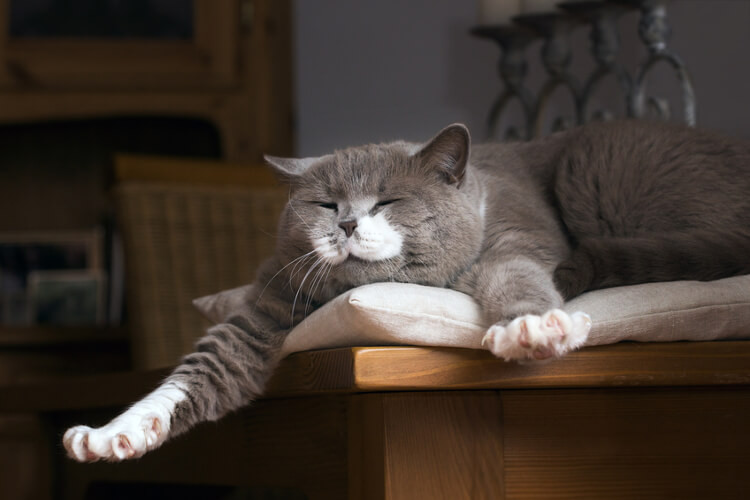Every Sunday morning I experience what I like to call ‘The Great Sprawl.’ Less like an old Western shoot-em-up starring your average grizzled Republican actor, much more like an old timey land grab, my cats stretch their bodies the length of the bed. My partner and I are rendered immobile until one or both cats decide it’s time for breakfast. Angus generally sits somewhere near my face (left paw near my jugular in case he’s feeling particularly mutinous). He prods me awake with purrs, meows or in extreme situations of deep sleep, fur-induced suffocation. While I’m aware that we register as nothing but lowly intruders who leave for eight to ten hours a day in order to provide them with crunchies, I often wonder – how much living space is enough to make our cats happy?
No Two Gatos Are Built the Same
 Squeaker modeling the apartment
Squeaker modeling the apartment
Our abode is adequately sized by L.A. standards, but nothing like our last place, which was twice the size with a long hallway perfect for impromptu mid-morning chases and French windows well suited for birdie watching. It occurred to me that this new lack of space might negatively impact my two furballs. So, how much square footage per cat is enough? No one wants to go all Grey Gardens and accidentally end up with a lot of one-sided conversation and a raccoon or two, now do they?
Though my quest to define exactly how much space cats need led me to no concrete answer, the blogosphere did turn up some relevant thoughts on the matter. One veterinarian suggested that five hundred square feet per cat was sufficient, while another site challenged that idea, stating that the answer is actually breed specific, meaning your average happy-go-lucky Maine Coone might not take so kindly to your purebred Persian, but if you throw a tabby into the mix, you might be in luck. Realtor.com researched which breeds are apartment-friendliest. It turns out that Siamese, Persian, Ragdoll, Maine Coone, Bengal and Sphynx breeds are all down for a mellow hang, some just fine with sleeping most of the day away.
Go Climb a Tree!
 Squeaker + Angus hanging out on their cat bridge
Squeaker + Angus hanging out on their cat bridge
Whether you are spatially impaired or not, you can utilize your space in a way that is advantageous to your cat. Tasteful perches that recognize the need for design can end up doubling your lil’ love’s square footage. And lucky you – designers are fast filling the need for aesthetically pleasing, minimally designed perches that don’t resemble high school woodshop projects. One house to inspire you is the Walkers’ San Diego Cat House, which was designed for the pure enjoyment of their eight cats and one long-suffering dog.
If you’re not ready to go full cat like the Walkers, I’ve had luck with Catastrophic Creations, which specializes in stylish bridges, sisal posts and cat shelves. The Humane Society promotes the use of catios, or similar enclosures, which allow your cats the freedom to go outside without the associated risks. If this idea floats your boat, you can find a bevy of YouTube tutorials on DIY catios, from cheap and basic to super fancy, or even commission a former architect to help you out.
Paying Rent in Cuddles
Remember – it’s their house as well and they likely spend a lot more time in it than you do. Be sure to create a warm, quiet and comfortable atmosphere that also engages your cat when he needs it. Keep it free of clutter with easy access to fresh air, food and water and an abundance of places to perch and hide (if necessary). Your cat might thank you with a tad more patience, or at the very least – a little extra sleep.







How do you work here ?
If your interested in writing for FPM, please send an email to support@catgenie.com for more information. 🙂